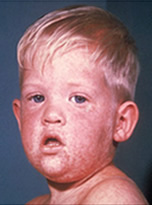Read and report vaccine reactions, harassment and failures.

Measles (Rubeola)
- Measles (rubeola) is a highly contagious respiratory disease spread by coughing, sneezing, or simply being in close contact with an infected individual. The disease can be spread even when the rash is not visible. Measles tends to be more severe in children under 5 and adults over 20.
- Initial measles symptoms include fever, cough, runny nose, red irritated eyes, and sore throat with tiny white spots on the cheeks inside the mouth (Koplik spots). These symptoms generally last 2-4 days and are followed by the signature itchy red rash which appears on the body around the fourth or fifth day. The rash usually begins on the head and moves down the body to the feet.
- After coming in contact with someone infected with measles, the incubation period to onset of the rash is between 7 and 21 days, with an average of 14 days. The period leading up to the appearance of the rash is characterized by a rising fever that peaks at 103-105 degrees F. Complications of measles can include bronchitis, diarrhea, ear infections, pneumonia, seizures, encephalitis and death.
- Studies have concluded that vitamin A reduces the risk of measles complications and death. Children with vitamin A deficiency, especially those living in underdeveloped countries, are at a higher risk of developing complications. Receiving measles immune globulin, a product made from human blood containing high levels of measles antibodies, within 6 days of exposure can mediate the severity of the illness.
- In 1960, three years before the first measles vaccine became available in the U.S., there were approximately 442,000 reported measles cases and 380 related deaths, among the 3.5 to 5 million Americans who were likely infected with measles. Historically, measles deaths have been reported at a rate of 1 in 10,000 cases. Measles-associated deaths are rare in the U.S. and the last reported death occurred in 2015. Globally, 95 percent of measles deaths occur in developing countries, where the disease is one of the leading causes of death among young children.
Measles Vaccine
- There are three measles vaccines currently in use in the United States. Two vaccines, MMRII and PRIORIX, are combination measles-mumps-rubella (MMR) live virus vaccines. The third vaccine, ProQuad, is a combination measles-mumps-rubella-varicella (MMR-V) live virus vaccine. Both MMRII and ProQuad are manufactured and distributed by Merck, while PRIORIX is manufactured and distributed by GlaxoSmithKline. The CDC recommends children receive the first dose of MMR vaccine between 12 and 15 months, and the second dose between 4 and 6 years.
- Mild side effects such as redness, rash or pain at the injection site, along with fever and swelling of the glands in the neck or cheeks have been reported following MMR or MMR-V vaccination. More serious side effects following vaccination include seizures, thrombocytopenia, pneumonia, meningitis, encephalitis, full body rash, brain damage, permanent loss of hearing, coma, and death.
- As of March 29, 2024, there have been 112,733 reports of measles-vaccine reactions, hospitalizations, injuries, and deaths following measles vaccinations made to the federal Vaccine Adverse Events Reporting System (VAERS), including 560 related deaths, 8,639 hospitalizations, and 2,162 related disabilities. Nearly 50% of those adverse events occurred in children three years old and under.
- As of April 1, 2024, there have been 1,367 claims filed in the federal Vaccine Injury Compensation Program (VICP) for injuries and deaths following measles vaccination, for 85 deaths and 1,282 serious injuries.
- Medical studies report that vaccinated persons can get measles because they either do not respond to the vaccine or the vaccine’s efficacy wanes over time. Vaccinated mothers do not transfer long-lasting maternal antibodies to their infants which would protect them for the first few months of life.
Food & Drug Administration (FDA)
- Measles, Mumps, Rubella and Varicella Virus Vaccine Live (MMR-V). Product Insert & Licensing Information
- Measles, Mumps and Rubella Virus Vaccine, Live (MMRII). Product Insert & Licensing Information
- Measles, Mumps and Rubella Vaccine, Live (PRIORIX). Product Insert & Licensing Information
Centers for Disease Control (CDC)
- CDC on Measles
- CDC on Measles Vaccination
- Measles Vaccine Information Statement (VIS) MMR
- Measles Vaccine Information Statement (VIS) ProQuad/MMR-V
Vaccine Reaction Symptoms & Ingredients
Our Ask 8, If You Vaccinate webpage contains vaccine reaction symptoms and more.
Search for Vaccine Reactions
NVIC hosts MedAlerts, a powerful VAERS database search engine. MedAlerts examines symptoms, reactions, vaccines, dates, places, and more.
Reporting a Vaccine Reaction
Since 1982, the NVIC has operated a Vaccine Reaction Registry, which has served as a watchdog on VAERS. Reporting vaccine reactions to VAERS is the law. If your doctor will not report a reaction, you have the right to report a suspected vaccine reaction to VAERS.
IMPORTANT NOTE: NVIC encourages you to become fully informed about Measles and the Measles vaccine by reading all sections in the Table of Contents, which contain many links and resources such as the manufacturer product information inserts, and to speak with one or more trusted health care professionals before making a vaccination decision for yourself or your child. This information is for educational purposes only and is not intended as medical advice.



